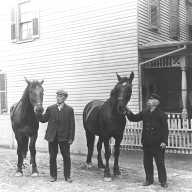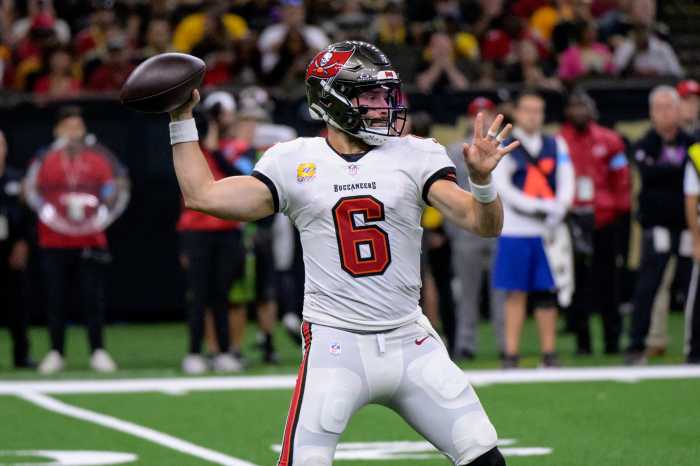Video games spur sales of real instruments
BY STEPHEN J. BRONNER
Reynaldo Ulloa has already become a guitar hero, so the next logical step for him is to learn to play guitar.
“I do want to learn how to play my favorite Guitar Hero songs on the guitar,” said the 18-year-old Hempstead resident, who has placed high in two of the game’s tournaments. “It would be better than tapping them on my plastic Les Paul.”
Guitar industry insiders are just beginning to see the potential in the immensely popular video games Guitar Hero and Rock Band, which they believe will bring in new guitarists like Ulloa, and therefore, new customers to a market that has been experiencing a national slump during the past two years.
“We’re beginning to think that there is a small undercurrent of the Guitar Hero and Rock Band customer that might be coming over to the dark side, for a lack of a better way of putting it, and actually buying guitars,” said Sammy Ash, Chief Operating Officer and an owner of Sam Ash, a national chain of musical instruments stores founded in Brooklyn. “We think that the kids are really getting into this whole concept: ‘Wow, you know what? Look what I can be with a toy, it can’t be that much harder to play guitar.'”
After nearly a decade of increasing sales, the American guitar industry hit a pinnacle in 2005, when nearly 3.5 million guitars were sold, according to statistics from the National Association of Music Merchants (NAMM), who tracks sales through manufacturers.
The next year, however, the amount of guitars sold dropped by nearly 10 percent. The worst hit market were the below $400 guitars, which are usually bought by people new to the instrument. Those numbers didn’t fare much better in 2007, with NAMM contributing the decline to a possible over-saturation of guitars in the marketplace.
“Sales were pretty flat from 2006 to 2007,” said Scott Robertson, Director of Marketing & Communications for NAMM.
However, on the video game side, since their releases last year in October and November, respectively, Guitar Hero and Rock Band have sold in record numbers, which industry insiders believe will propel guitar sales in 2008.
Activision, who distributes Guitar Hero, has sold 9.41 million copies in America of its latest iteration, Guitar Hero III: Legends of Rock, as of early August, according to Vgchartz.com, a web site that tracks video game sales. MTV Games’ Rock Band, which requires a more expensive purchase of a full band setup, has sold 3.17 million copies nationally.
“These music simulation titles are definitely hot right now and are showing no signs of slowing down,” said David Riley, Director of Public Relations for Entertainment, Software and Toys at the NPD Group, a leading global provider of consumer and retail market research information for a wide range of industries. “In its relatively short life at retail, Guitar Hero has already become one of the top 10 video games franchises in terms of dollar sales.”
While it is tough to pin down the exact impact that Guitar Hero has had on the guitar market, many retailers and industry insiders have their thoughts on the matter.
“My own personal theory is very simple, we’re reaching close to 20 million Guitar Hero purchases,” Ash said. “If one percent, and that’s it, it’s just one percent of the people who own Guitar Hero decide that, ‘you know what? Let me go out and buy a guitar.’ That’s 200,000 guitars coming into a market that didn’t exist before. It’s one of the very first times a crossover is going on.”
Kai Huang, President of RedOctane, who develops Guitar Hero, said that his company’s game, where players match colored buttons on a plastic guitar to different tracks on the screen, would attract people to the real thing.
“Anecdotally, we’ve heard from music teachers and store owners that business has increased two to three times since Guitar Hero was released,” he said. “Since Guitar Hero allows players to feel the rock star experience, it’s natural that those who play the game would want to pick up and play a real guitar.”
The impact is already being felt locally. Brooklyn resident Danny Polinsky, 30, comes from a family full of guitar players, but it was not until he started playing Guitar Hero that he felt inclined to purchase one for himself.
“Once I did that, I started seriously considering buying a real one, and when I had a little extra money, and a desire to really start learning, I bought a Takamine GS430S NEX Acoustic Guitar,” Polinsky said. “It’s pretty nice.”
However, John Oliva, a manager at the Music Zoo in Little Neck, was a little more cautious, saying the games polarize people. “I do think that the video games have sparked interest to play guitar, but it hasn’t been long enough,” he said. “It might have taken some people who were interested minimally [in playing guitar] and taken them to the video games because it’s easier.”
Robertson said that members of NAMM have also been split on the game’s impact on the industry, but the organization believes it is clearly having a major affect. “Is it creating more music makers, more guitar players? We see a lot of evidence that it is,” he said. “We heard some statistics before the third version of the game came out from RedOctane and Activision. They said that basically 10 percent of the people who play the game go on to show an interest to moving to the real thing and playing real guitar also.”
Meanwhile, scientific research paid for by a NAMM grant, is currently underway and could lead to more scientific results, according to Robertson.
“We’re real excited to fund a brand new study with Drexel University that’s coming up that really puts some science to ‘do the skills that you acquire in virtual music making translate to the benefits of playing a musical instrument and is that path, from virtual to real world, viable?'” The grant, of which Robertson could not give an amount, was given to the Philadelphia school after they made a proposal to NAMM.
“I believe it’s the first real scientific study on Guitar Hero that’s been done as it relates to music making,” Robertson said. “We’re excited to see the findings and believe it will be very interesting and help us understand this connection at a greater level.”
Although some Guitar Hero players may take playing the video game to the next level, Jeff Starace, 17, from Bayside, gave a similar reason to other teens about why they play music games. “It’s fun,” he said outside a Gamestop in Bayside. “You listen to good songs and play video games at the same time.”
Players of the game embrace this “rock star experience” and feel like they could be musicians, Robertson said. “Guitar Hero, and the whole genre, has really resonated with people,” he said. “They’re giving people positive experiences where they could feel what it’s like to be musical for the first time in their lives, and we think those experiences will lead to those desires to pursue a real life experience.”
Players are still flocking to the store to pick up the games, whose sequels are due out by the holidays of this year. Guitar Hero IV and Rock Band 2 boast even more features and songs and will sell just as well, if not better than their predecessors, Riley said.
“Given the fact that 50 percent of the total year’s sales occur during the last three months of the calendar year, and looking at current sales, there’s no reason to believe these titles won’t be flying off the shelves.”
Who knows? With so many copies sold, maybe the next generation of rock legends will have had their start with video games, suggests Aerosmith guitarist Joe Perry.
“Fans want to get and experience music in new formats – and there are going to be some of them who will play the game, then pick up the guitar for real and start bands,” Perry said in a press release for Guitar Hero: Aerosmith. “It’s what’s happening now, and it’s only going to build more momentum in the future. It’s going to give guitar and music a boost. It may turn a lot of musicians into gamers and gamers into musicians.”






























